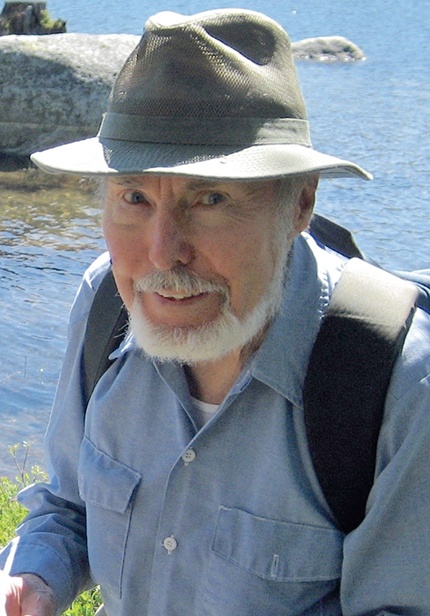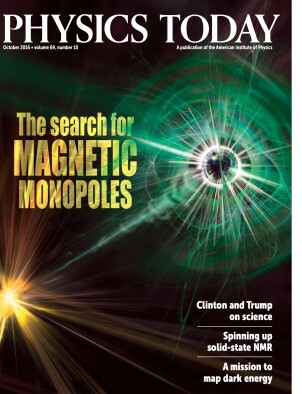John David Jackson
DOI: 10.1063/PT.3.3338
John David Jackson, professor emeritus at the University of California, Berkeley, whose magisterial textbook Classical Electrodynamics has shaped graduate education for more than a half century, died on 20 May 2016 in Lansing, Michigan. His wide-ranging theoretical work combined fine craftsmanship, intuition born of meticulous scholarship, engagement with experiment, and respect for practical matters. He was a wise counselor and a tireless advocate for human rights and academic freedom.

John David Jackson
NAN JACKSON

Born on 19 January 1925 in London, Ontario, Canada, Jackson earned his BSc in honors physics and mathematics at the University of Western Ontario in 1946. The undergraduate curriculum’s emphasis on electromagnetism pointed him toward MIT and its Research Laboratory of Electronics. His initial graduate research, carried out with Lan Jen Chu, concerned a field theory of traveling-wave tubes.
Victor Weisskopf’s quantum mechanics course introduced Jackson to modern physics and attracted him to Weisskopf’s nuclear theory group. With postdoc John Blatt, Jackson analyzed low-energy nucleon–nucleon scattering; for his dissertation in 1949 he used Julian Schwinger’s variational method to investigate S- and P-wave proton–proton scattering.
Jackson was appointed in 1950 to the mathematics faculty at McGill University, where he continued research on atomic processes and nuclear reactions and began his career as a revered teacher and mentor. The lecture notes for his course on electricity and magnetism evolved into a first draft of the famous textbook.
In 1956–57 Jackson spent a sabbatical year at Princeton University and was free to focus on research. A New York Times account of Luis Alvarez and collaborators’ observation of muon-catalyzed fusion, and the prospect it raised of a new energy source, stirred his imagination. Within a week, Jackson estimated that one muon could catalyze no more than 130 deuterium–tritium fusion reactions, insufficient for practical energy production. That work led him to form lasting bonds with other “Mu-sketeers,” Russian physicists who pioneered and extended muon-catalysis theory. Following Chien-Shiung Wu and coworkers’ discovery of parity nonconservation in beta decay, Jackson, Sam Treiman, and William Wyld analyzed possible signatures for violations of time-reversal invariance.
Jackson moved in 1957 to the University of Illinois at Urbana-Champaign. Inspired, he claimed, by the majesty of Midwestern thunderstorms, he developed the fearsome “Jackson problems” and in 1962 published the first edition of Classical Electrodynamics. His research interests included low-energy kaon–nucleon scattering, final-state interactions, and dispersion relations.
A 1963–64 sabbatical at CERN in Geneva marked another decisive turn in Jackson’s research career. With Kurt Gottfried, he devised incisive methods to elucidate production mechanisms of resonances in two-body to two-body reactions. Insights they gained from the phenomenological analysis of resonances led them to develop the peripheral model with absorption of low partial waves to describe resonance production.
Jackson joined the Berkeley faculty and the Lawrence Berkeley Laboratory staff in 1967, when the ascendancy of Regge theory put his beloved special functions at the heart of theoretical physics. Lecturing graduate students in 1968, and having covered every blackboard in the room with arcane calculations that culminated in Legendre functions of the second kind, he mused, “Born a century too late!”
As leader of the Theory Year program at Fermilab in 1972–73, Jackson founded a lab institution, the Joint Experimental–Theoretical “Wine & Cheese” Seminar.
Back at Berkeley, Jackson was in at the very beginning of the “November Revolution” of 1974. Alerted by colleagues to the discovery-in-progress of the ψ resonance in electron–positron annihilations at SLAC, he deduced in real time that the new particle was astonishingly narrow—with a total width less than 100 keV. Drawing on his broad scientific culture, he provided diverse insights into polarization in electron storage rings and the nature of the charmonium and upsilon families of heavy mesons.
Jackson served the physics community at Berkeley and around the world in many ways. An early proponent of the Superconducting Super Collider, he served for two years as deputy director of operations for the SSC Central Design Group. He edited the Annual Review of Nuclear and Particle Science for 17 years.
Jackson became a naturalized US citizen in 1988. The American Association of Physics Teachers established the John David Jackson Award for Excellence in Graduate Physics Education in 2010. A certificate conferring the title of Honorary Woman, presented by female graduate students in recognition of his outstanding achievements as department chair, hung on his living room wall for three decades.
After his formal retirement in 1993, Jackson remained active in research and community service, and he published numerous articles on pedagogical insights and physics history. Throughout his life he enjoyed mountain photography and listening to jazz.
Dave’s colleagues and students recall with affection the twinkle in his eyes conveying the joy of insight, his uncompromising standards, and his generous spirit. We celebrate his example as a physicist, teacher, and humane world citizen.
More about the Authors
Chris Quigg. Fermi National Accelerator Laboratory, Batavia, Illinois.
